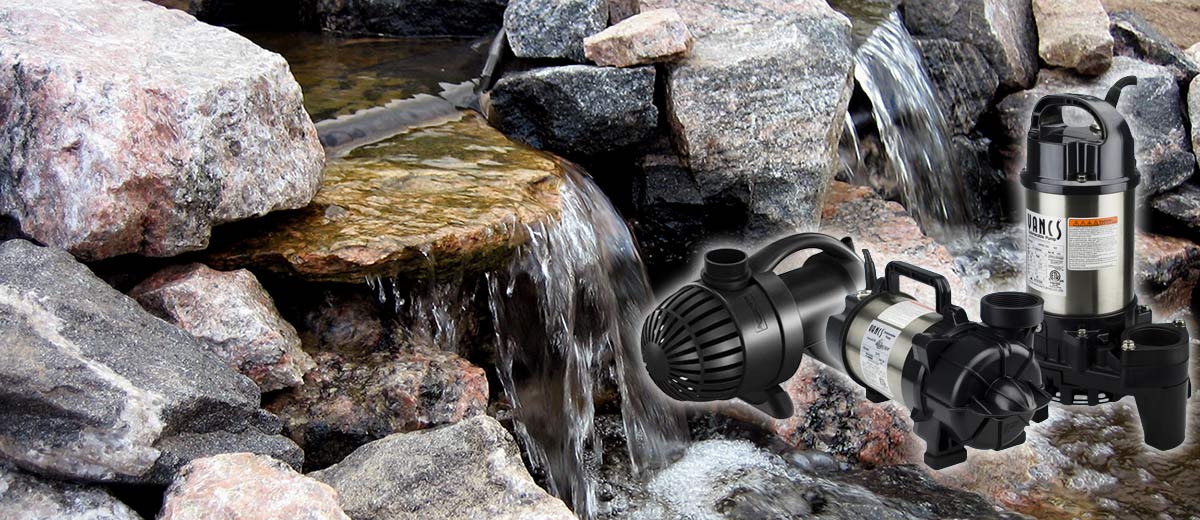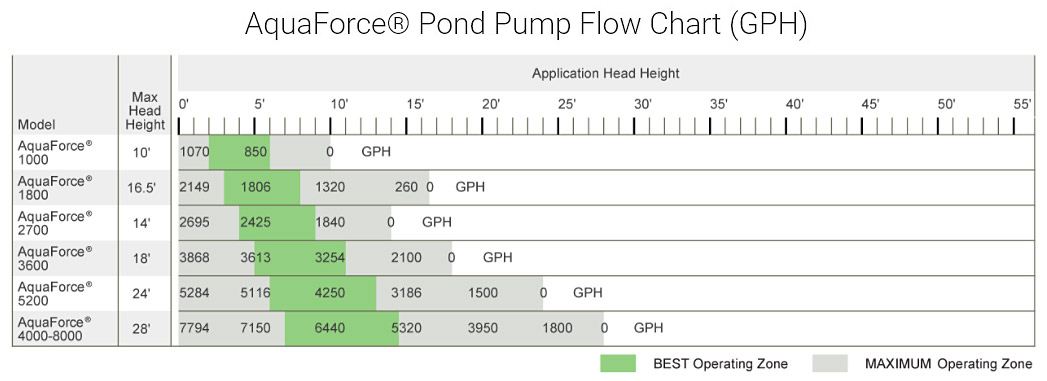Choosing the right pond pump can be a bit confusing, there are many models and brands to choose from nowadays, how do you choose? Although the initial purchase price is usually the main consideration when buying a pond pump, there are a few other more important aspects to bear in mind.
Here are some factors that you may want to consider when purchasing a pump for your pond or waterfall.

The size of your pond is critical in determining what pump to buy. Too small a pump will cause poor circulation and stagnant area in your pond leading to low oxygen levels, sludge build-up and poor water quality. These factors result in an unhealthy pond and in turn unhealthy fish. At minimum, your pump should circulate the volume of your pond once every 2 hours. If you have koi, ideally this should be increased to circulating the volume of your pond once per hour.
Example:
If you have a waterfall, achieving the right ‘look’ depends on the flow of water coming over falls. A small pump on a large waterfall results in the water just trickling over the rocks, which is great if that is the desired effect. However if you are looking for a gushing flow (a miniature Niagara Falls) then a larger pond pump is obviously necessary. But how large? The size of pump you need really depends on the look you are trying to achieve and the width of your waterfall.
Here is a general rule of thumb to achieve the look and sound you want based on the amount of water flowing over 1″ of width of your waterfall:
100 GPH per inch of waterfall = somewhat more than trickle
150 GPH per inch of waterfall = medium flow
200 GPH per inch of waterfall = strong flow
To calculate how much flow you need for your waterfall, all you need to do is measure the width of your waterfall (in inches) and multiply that by 100, 150, or 200 depending on the look you are trying to achieve.
Example 1
If your waterfall is 10” wide and you want a trickle – do the following calculation:
Example 2
If your waterfall is 18″ wide and you want a strong flow – do the following calculation:
Dynamic head pressure sounds (and can be) complicated, but for the purposes of selecting a pond pump you don’t need to get too precise. If you have a small pond or don’t have a waterfall or stream, then you can ignore it altogether.
Basically, dynamic head pressure can be thought of as all the back pressure that is put onto the pump while it is forcing water through the tubing up to the top of your waterfall, stream or filter. This includes the height of your waterfall (vertical height above pond water level), length and diameter of tubing, fittings, such as elbows and ball valves, etc. The more dynamic head pressure there is – the harder your pump has to work and the less flow you will get out of your pump.
Example:
Add up all of these factors to find out your Dynamic head Pressure.
6′ Waterfall Height Factor
4′ Tubing length Factor (37/10 =3.7)
3′ Number of Fittings Factor
13′
The result is 13′ of Dynamic Head Pressure.
Also note, that choosing the right size tubing is also crucial to minimize dynamic head pressure. Smaller diameter tubing creates more head pressure and reduces pump flow more than large tubing. For more information see our How To Choose The Correct Size Pond Tubing page.
This means that although the actual vertical height of the waterfall is only 6′, the pump has to work as hard as if the waterfall height is 13′. If you want to have 3600 GPH flowing over your waterfall, you will need to buy a pond pump that provides 3600 GPH at 13′ of head, not just a pump that provides 3600 GPH. Most pumps are sized according to their flow rate at 0′ or 1 ‘ of head. A typical 3600 GPH pump might only provide 2000 GPH or less at 13’ of head.
Most pump manufactures provide a flow chart for their pumps like the one below, indicating the flow at varying heights so you know exactly what the flow rate will be at your desired head height.
Based on the flow chart below, if you want 3600 GPH coming over your water fall that was calculated to have 13′ of dynamic head, you would want to choose the AquaForce 5200 pump

This often overlooked factor often determines the real cost of buying and operating a pump. If you have fish in your pond, your pump should be running 24 hours a day except in winter. If you have an older style pump that is a ‘direct drive style’ pump like a typical sump pump, it can significantly affect your electricity bill.
Lets compare 3 pond pumps:
| PUMP | Little Giant WGP-80-PW | AquaForce 3600 | Aquascape 3-PL |
|---|---|---|---|
| PRICE | $259.99 | $399.99 | $799.99 |
| FLOW RATE | 3500 GPH | 3868 GPH | 3000 GPH |
| WATTS | 700 | 215 | 320 |
| OPERATING COST (per year) | $512.06 | $157.28 | $234.09 |
| OPERATING COST AFTER YEAR 2 | $1024.12 | $314.56 | $468.18 |
| OPERATING COST AFTER YEAR 3 | $1536.18 | $471.84 | $702.27 |
| ACTUAL COST OF PUMP AFTER 3 YEARS | $1796.17 | $871.83 | $1502.26 |
*Based on 8 months operation per year (April through November) @ $.12 per Kilowatt hour
RESULTS:
As seen in the table above, the energy efficiency of a pump greatly effects the operating cost of a pump. This has has a significant impact of the overall cost of ‘Owning’ a pump.
As you can see, the purchase price is only a small part of the actual price of owning a pump. Initially, the Little Giant pump costs less to purchase, but costs much more to operate than the other pumps because of its’ energy consumption. In fact by the end of the third year, the less expensive Little Giant pump costs more to own than the 3-PL pump to own, and costs more than double the AquaForce 3600 pump.
Obviously, pond pumps with longer warranties are preferable. This means the manufacturer stands behind the product and generally it is going to provide you with years of dependable service.
As you can see, choosing the right pump for your pond involves more than just looking at the price and the size of the pump. In order to get the flow you are looking for, you need to other factors into consideration, such as the height of your waterfall and length of tubing you need. It also pays off to spend a bit more money on a pump that is energy efficient, because it will save you money in the long run. A cheap pump often costs you more than an expensive pump after a couple years.
With a little homework, you can make an informed choice. Select a well known brand of pump and consider both the price tag of the pump, how energy efficient the pump is, and the warranty before purchasing one.